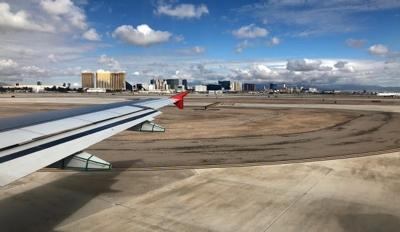Fri, Apr 25, 2025
DCA Accident Spurs Moves To Prevent Similar Traffic Conflicts
The FAA published a media update concerning actions it is taking in response to the January midair collision between a helicopter and commercial airliner at Reagan Washington National Airport in D.C., outlining some initial solutions coming out of ongoing internal rotorcraft safety roundtable discussions. Some immediate actions were implemented to permanently restrict non-essential helicopter traffic and to eliminate mixed traffic in the vicinity of the airport.

The collision exposed hazards involving the mix of helicopters and fixed-wing aircraft at DCA, and the FAA immediately began examining other hotspot airports with charted routes for both helicopter and fixed-wing traffic.
The FAA first focused on Harry Reid International Airport (LAS) in Las Vegas, Nevada due to issues that immediately emerged in the analysis.
One example is that agreements with local helicopter operators require them to avoid arrival and departure corridors that lack defined lateral or vertical measurements. Another is that tower controllers do not issues traffic advisories between returning air tour helicopters and arriving or departing airplanes. This results in routine lack of compliance with Class B separation rules.

The agency immediately implemented positive control over helicopters and began issuing more traffic advisories. This resulted in the number of traffic alert and collision avoidance system reports fell off by 30% in just three weeks.
The FAA is planning additional actions at LAS, and is continuing to analyze other airports as well for issues that, in their assessment, require immediate actions.
An additional item noted by the FAA is that mixed traffic refers to not just airplanes-helicopters, but also mixed operations for example, between slower and faster moving airplanes. The agency is analyzing potential traffic conflicts around closely-spaced airports such as at Hollywood Burbank (KBUR) and Van Nuys (KVNY), airports that are less than ten miles apart, serve a wide mix of aircraft, and have closely-spaced arrival and departure paths.
More News
He Attempted To Restart The Engine Three Times. On The Third Restart Attempt, He Noticed That Flames Were Coming Out From The Right Wing Near The Fuel Cap Analysis: The pilot repor>[...]
Make Sure You NEVER Miss A New Story From Aero-News Network Do you ever feel like you never see posts from a certain person or page on Facebook or Instagram? Here’s how you c>[...]
From 2009 (YouTube Edition): Leading Air Show Performers Give Their Best Advice for Newcomers On December 6th through December 9th, the Paris Las Vegas Hotel hosted over 1,500 air >[...]
Aero Linx: NASA ASRS ASRS captures confidential reports, analyzes the resulting aviation safety data, and disseminates vital information to the aviation community. The ASRS is an i>[...]
“For our inaugural Pylon Racing Seminar in Roswell, we were thrilled to certify 60 pilots across our six closed-course pylon race classes. Not only did this year’s PRS >[...]
 NTSB Final Report: Rutan Long-EZ
NTSB Final Report: Rutan Long-EZ ANN FAQ: Turn On Post Notifications
ANN FAQ: Turn On Post Notifications Classic Aero-TV: ICAS Perspectives - Advice for New Air Show Performers
Classic Aero-TV: ICAS Perspectives - Advice for New Air Show Performers ANN's Daily Aero-Linx (06.28.25)
ANN's Daily Aero-Linx (06.28.25) Aero-News: Quote of the Day (06.28.25)
Aero-News: Quote of the Day (06.28.25)




